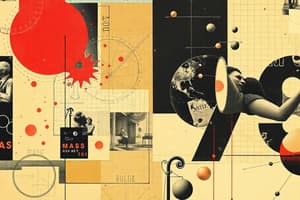Podcast
Questions and Answers
Which group of elements is known for being highly reactive nonmetals?
Which group of elements is known for being highly reactive nonmetals?
- Transition Metals
- Noble Gases
- Alkaline Earth Metals
- Halogens (correct)
What property distinguishes metalloids from metals?
What property distinguishes metalloids from metals?
- They exhibit mixed properties of metals and nonmetals. (correct)
- They are always gases at room temperature.
- They are excellent conductors of heat and electricity.
- They are ductile and malleable.
Why do alkali metals typically form 1+ cations?
Why do alkali metals typically form 1+ cations?
- They gain two electrons.
- They lose one electron. (correct)
- They lose two electrons.
- They gain one electron.
What characteristic is shared by noble gases?
What characteristic is shared by noble gases?
What makes alkaline earth metals less reactive than alkali metals?
What makes alkaline earth metals less reactive than alkali metals?
Who discovered the electron in 1897?
Who discovered the electron in 1897?
What model did J.J. Thomson propose to explain the structure of the atom?
What model did J.J. Thomson propose to explain the structure of the atom?
What is the charge of a neutron?
What is the charge of a neutron?
Which particle was discovered by James Chadwick in 1932?
Which particle was discovered by James Chadwick in 1932?
What defines the atomic number (Z) of an element?
What defines the atomic number (Z) of an element?
In the formula for mass number (A = p + n), what do the variables p and n represent?
In the formula for mass number (A = p + n), what do the variables p and n represent?
What did Rutherford's gold foil experiment primarily demonstrate?
What did Rutherford's gold foil experiment primarily demonstrate?
Which statement is true regarding the mass of protons and neutrons?
Which statement is true regarding the mass of protons and neutrons?
What pattern did Mendeleev observe when he arranged the elements by increasing mass?
What pattern did Mendeleev observe when he arranged the elements by increasing mass?
What did Mendeleev's table allow him to predict?
What did Mendeleev's table allow him to predict?
How is the modern periodic table organized compared to Mendeleev's table?
How is the modern periodic table organized compared to Mendeleev's table?
What defines the main-group elements in the periodic table?
What defines the main-group elements in the periodic table?
What is the total number of vertical columns in the periodic table?
What is the total number of vertical columns in the periodic table?
Which elements are classified as transition metals?
Which elements are classified as transition metals?
What characteristic is typical of metals found in the periodic table?
What characteristic is typical of metals found in the periodic table?
Why was Mendeleev's classification based on atomic weight problematic?
Why was Mendeleev's classification based on atomic weight problematic?
How many neutrons does a chlorine atom with a mass number of 35 contain?
How many neutrons does a chlorine atom with a mass number of 35 contain?
If a carbon atom has a mass number of 14 and an atomic number of 6, how many neutrons does it contain?
If a carbon atom has a mass number of 14 and an atomic number of 6, how many neutrons does it contain?
For the isotope with mass number 40 of argon, which of the following is the correct number of neutrons?
For the isotope with mass number 40 of argon, which of the following is the correct number of neutrons?
Which element has isotopes that all have the same number of protons?
Which element has isotopes that all have the same number of protons?
What is the electron configuration of an O-2 anion?
What is the electron configuration of an O-2 anion?
What distinguishes cations from anions?
What distinguishes cations from anions?
How many neutrons are present in the nitrogen isotope N-15?
How many neutrons are present in the nitrogen isotope N-15?
Which of the following statements about isotopes is true?
Which of the following statements about isotopes is true?
Flashcards are hidden until you start studying
Study Notes
Subatomic Particles
- J.J. Thomson discovered the electron in 1897 and proposed the Plum Pudding Model.
- Robert Millikan's oil-drop experiment in 1909 measured the electron's charge.
- Ernest Rutherford's gold foil experiment in 1909 led to the discovery of the nucleus.
- Rutherford proposed the Nuclear Model (or Planetary Model) with a dense, positively charged nucleus and surrounding electrons.
- Eugen Goldstein in 1886 discovered canal rays, indicating positive charges.
- Rutherford in 1917 identified the proton as a positively charged particle in the nucleus.
- James Chadwick in 1932 discovered the neutron, explaining the missing mass.
- All atoms are composed of Protons, Neutrons, and Electrons.
- Protons and neutrons have nearly identical masses.
- The charge of the proton and the electron are equal in magnitude but opposite in sign.
- The neutron has no charge.
Atomic Number
- The number of protons in an atom’s nucleus is its atomic number and is given the symbol Z.
- The number of protons defines the element, because every element has a different number of protons.
Mass Number
- Mass number is the sum of the number of neutrons and protons in an atom and is represented by the symbol A.
- A = number of protons (p) + number of neutrons (n)
- A=p+n
Isotopes
- All atoms of a given element have the same number of protons.
- Atoms with the same number of protons but a different number of neutrons are called isotopes.
- The relative amount of each different isotope in a naturally occurring sample of a given element is roughly constant.
- These percentages are called the natural abundance of the isotopes.
Ions
- The number of electrons in a neutral atom is equal to the number of protons in its nucleus (designated by its atomic number Z).
- During chemical change, atoms can lose or gain electrons and become charged particles called ions.
- Positively charged ions, such as are called cations.
- Negatively charged ions, such as are called anions.
Periodic Law and the Periodic Table
- In 1869, Dmitri Mendeleev noticed that certain groups of elements had similar properties.
- Mendeleev observed that when elements are listed in order of increasing mass, these similar properties recurred in a periodic pattern.
- Mendeleev summarized these observations in the periodic law: When the elements are arranged in order of increasing mass, certain sets of properties recur periodically.
- Mendeleev arranged the known elements in a table and placed elements with similar properties in the same vertical columns.
- Mendeleev's table contained gaps, which allowed him to predict the existence (and even the properties) of yet undiscovered elements.
- In 1886, eka-silicon was discovered by Clemens Winkler, who named it germanium.
Modern Periodic Table
- In the modern table, elements are listed in order of increasing atomic number rather than increasing relative mass.
- The modern periodic table also contains more elements than Mendeleev’s original table.
- The periodic table can also be divided into main-group elements and transition elements or transition metals.
- The periodic table has 18 vertical columns called groups and 7 horizontal rows called periods.
- Main-group elements are in columns 1A–8A (groups 1, 2, 13–18).
- Subgroup elements or transition metals are in columns 3–12 (B groups).
Classification of Elements
- Elements are broadly classified as metals, nonmetals, and metalloids.
- Metals: Lower-left side and middle of the periodic table; good conductors of heat and electricity, malleable, ductile, often shiny, tend to lose electrons.
- Nonmetals: Upper-right side of the periodic table; varied states at room temperature (solids, liquids, gases), poor conductors of heat and electricity, not ductile or malleable, tend to gain electrons.
- Metalloids (Semimetals): Along the zigzag line dividing metals and nonmetals; exhibit mixed properties of metals and nonmetals, often semiconductors with temperature-dependent conductivity.
Group Classifications
- Alkali Metals (Group 1A): Highly reactive metals (e.g., Lithium, sodium, potassium, rubidium, cesium).
- Alkaline Earth Metals (Group 2A): Reactive, but less so than alkali metals (e.g., Magnesium, Calcium, Strontium, Barium).
- Halogens (Group 7A): Very reactive nonmetals (e.g., Fluorine, Chlorine, Bromine, Iodine).
- Noble Gases (Group 8A): Mostly unreactive, chemically stable (e.g., Helium, Neon, Argon, Krypton, Xenon).
Ions and the Periodic Table
- A main-group metal tends to lose electrons, forming a cation with the same number of electrons as the nearest noble gas.
- A main-group nonmetal tends to gain electrons, forming an anion with the same number of electrons as the nearest noble gas.
Studying That Suits You
Use AI to generate personalized quizzes and flashcards to suit your learning preferences.




